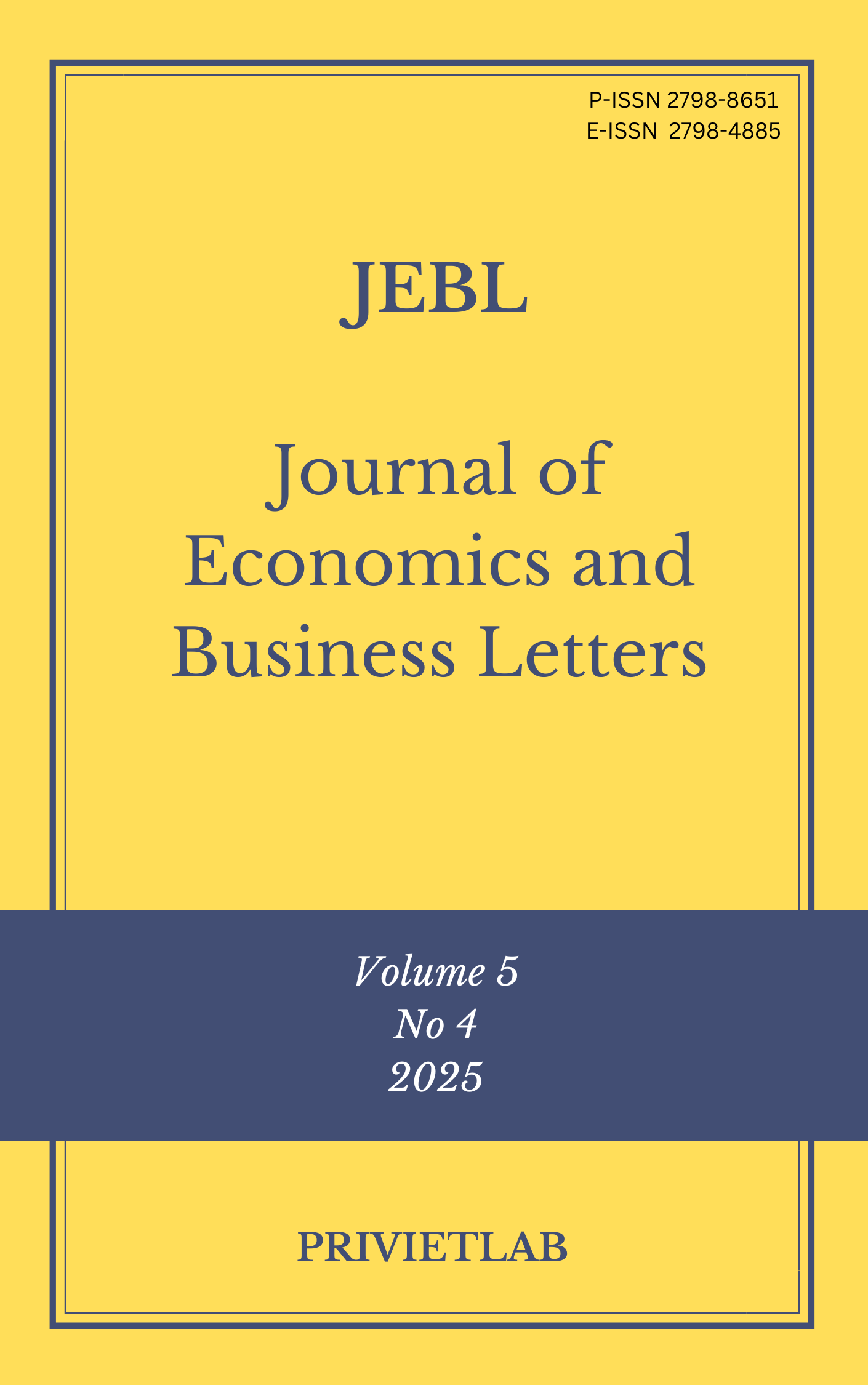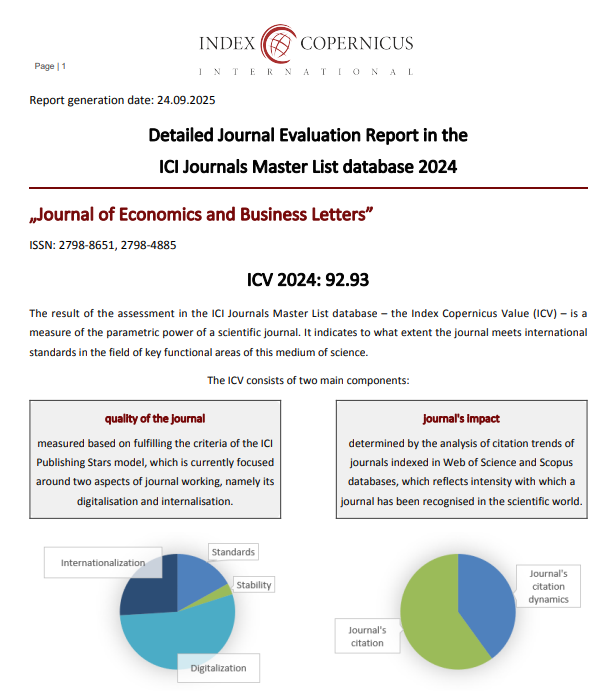Integrating product portfolio and supply chain design for sustainable construction
DOI:
https://doi.org/10.55942/jebl.v5i4.380Keywords:
Public Infrastructural, ICT, Electricity, Transportation, Economic GrowthAbstract
This study examined the relationship between public infrastructure expenditure on information technology, electricity and economic growth using real gross domestic products as proxy. The methods of data analysis and estimation technique are Ordinary Least Square (OLS) method, Augmented Dickey Fuller (ADF) method, Unit Root Test, Johansen Co-integration Test and Error Correction Model. Data on these variables from 1981 to 2021 were sourced from the Central Bank of Nigeria Statistical Bulletin (CBN, 2021) and World Development indicators. The evidence from the long-run coefficient of public expenditure on infrastructural development has significantly impacted on economic growth, therefore infrastructure development expenditure is seen to constitute significant determinant of economic growth particularly for developing countries. The study suggested analysis of the elasticity of growth towards public expenditure on economic services and government need to take proactive and concerted effort to significantly enhance economic growth through fiscal policy targeted on sustainable economic service provision.
References
Abu, N, & Abdullahi, U. (2010). Government Expenditure and Economic Growth in Nigeria, 1970-2008: A Disaggregated Analysis, Business and Economics Journal, 1–11.
Agundu, P & Umor, C. (2016). Prudence in Public Institutions Management: The Strategic Financial Efficiency Challenge in Nigeria. An International Multi-Disciplinary Journal, Ethiopia AFRREV @ Ten, Vol. 10(5), Serial No.44, 161-180 DOI: http://dx.doi.org/10.4314/afrrev.v10i5.12
Akinyosoye, M. (2010). Infrastructure development in Nigeria: Road map to sustainable development Working Paper Aschauer DA (1989). Is public expenditure productive? Journal of Monetary Econ., 23, 177-200.
Aregbe, T, A. & Ekpung E. (2015). An analysis of government spending and economic growth in Nigeria. International Journal of Development Research, 5(06), 4876-4882.
Ashakah, F, & Ogbebor, T (2022). Infrastructure, Human Capital Development and Economic Growth in Nigeria: An Empirical Investigation . Journal of Economics and Development Studies 1(2):144-163
Asher, S & Novosad, P (2020). Rural Roads and Local Economic Development. American Economic Review, 110(3), 797–823
Bhattacharya, R; Gupta, A, & Sikdar S (2020). Building Infrastructure to Promote Inclusive Growth. National Institute of Public Finance and Policy Working Paper No. 20/321
Bhatia, H.L (2002), Public Finance, 25th Edition, Vikas Publishing House, PVT Ltd, New Delhi
Central Bank of Nigeria statistical bulletin (CBN, 2021). https://www.cbn.gov.ng/Out/2021/STD/2021Q1%20Statistical%20Bulletin_Contents%20and%20Narratives_Final.pdf
Chude, N.P; Chude, D.1 (2013): Impact of Government Expenditure on Economic Growth in Nigeria, International Journal of Business and Management Review, 1(4), 64-71
Deinne, C, E (2021). Inequalities in access to infrastructural amenities and sustainable development in Delta State, Nigeria. / Ghana Journal of Geography, 13(2) DOI:10.4314/gjg.v13i2.8
Devarajan,S., Swaroop, V., Zou Heng.Fu (1993), The Composition of Public Expenditure and Economic Growth, Journal of Monetary Economics, 37, 313-344
Donaldson, D (2018). Railroads of the Raj: Estimating the Impact of Transportation Infrastructure. American Economic Review, 108(4-5), 899-934
Edame, G, E (2014); Trends Analysis of Public Expenditure on Infrastructure and Economic Growth in Nigeria, International Journal of Asian Social Science, l.4 (4)
Ejima, S, N: Ikpefan, A: & Itai M, M. (2024). Liquidity Management Effects on Manufacturing
Performance During Recession Period in Nigeria. Innovations, no. 79
Ibikunle, B, Ojo, A, & Kuyebi, E. (2021). Policy on public-private partnerships and road infrastructure in Nigeria: a lesson from Lekki/Epe Concession Company. International Journal of Social Sciences and Education Research 4(2):283-296
Johansen-Juselius, K (1992). Testing structural hypotheses in a multivariate cointegration analysis of the PPP and the UIP for UK. Journal of Econometrics. 53(1–3), 211-244. https://doi.org/10.1016/0304-4076(92)90086-7
KPMG (2007). Trends in Global Real Estate. Retrieved from http://www.kpmg.com/Global/ IssuesAndInsights/ ArticlesAndPublications/Pages/Trends-globalrealestate.aspx
Maku, O, E, (2014) Public Expenditure and Economic Growth Nexus in Nigeria: A Time Series Analysis, Public Expenditure and Economic Growth Nexus in Nigeria: IISTE International Knowledge Sharing Platform. A Time Series Analysis, ISSN 2224-5731(Paper) ISSN 2225-0972(Online) .4(7), 2014.
Mohanty R. K., & Bhanumurthy N. R. (2019). Analysing the dynamic relationships between physical infrastructure, financial development and economic growth in India. Asian Economic Journal, 33(4), 381–403
Moses, C. L., Olokundun, M., Falola, H., Ibidunni , S., Amaihian, A., & Inelo, F. (2016). A review of the challenges militating against women entrepreneurship in developing nations. Mediterranean Journal of Social Sciences, 7(1), 64-49. doi:10.5901/mjss. 2016.v7n1p64
Mullins, Laurie J. (2005), Management and Organizational Behaviour, Harlow, England ; New York : Prentice Hall. https://archive.org/details/managementorgani0000mull_no6?utm_source=chatgpt.com
Mutiu, A.O; Olusijibomi, A. (2013), Public Expenditure and Economic Growth Nexus: Further Evidence from Nigeria, Journal of Economics and International Finance, 5(4).146-154
Niyoy, B.Emranul, Osborn, D (2003). Public Expenditure and Economic Growth: A Disaggregated Analysis for Developing Countries, 2003 retrieved from www.social sciences.Manshester.ac.uk
Ogbari, M.E.; Chima, G.U.; Olokundun, M.A.; Olarewaju, F.O.; & Ufua, D.E. (2022). Exploring the influence of environmental complexity on entrepreneurial decision making: A conceptual review. J. Akunt. Bisnis J. Program Studi Akuntansi 8, 78–86. DOI: 10.31289/jab.v8i2.751
Ogunjimi, J.A. & Amune, B.O. (2017). Impact of Infrastructure on Foreign Direct Investment in Nigeria: An Autoregressive Distributed Lag (ARDL) Approach. Munich Personal RePEc Archive Paper No.75996, 1-17, 2017. https://mpra.ub.unimuenchen.de/75996/1/MPRA_paper_75996.pdf on December 18, 2017
Okoro, A.S (2013). Government Spending and Economic Growth in Nigeria (1980-2011), Global Journal of Management and Business research Economic and Commerce,13(5), 2249-4588
Onyekwelu, S. (2017), The Nigeria Real Estate Market Review and Strategic Outlook 2017, Ubosi Eleh & Co., Lagos, Nigeria.
Opara, M, (2023). Public-Private Partnerships in West Africa: A Policy Comparison of Nigeria and Ghana March 2023 International Journal of Business and Management 18(2):158 DOI:10.5539/ijbm.v18n2p158
Owolabi, O.A, Adedeji,A.O, Aderunmu,B, Oku, A.O, and Ogunbiyi, T (2023). Do information and communications Technology (ICT) and Financial Development Contribute to Economic Diversification? Evidence from Sub-Sahara Africa. Journal of Economic Structures 12(5). doi.org/10.1186/s40008-023-00299-7.
Oyoko, V; Peter, T, & Jegede, D (2023). Inadequacy of Infrastructural Facilities in Public Universities in Nigeria: Causes, Effects and Solutions. International Journal on Integrated Education. https://journals.researchparks.org/index.php/IJIE
Popov, A. (2018). Evidence on finance and economic growth in: Beck, Thorsten and Ross Levine (Eds.): Handbook of Finance and Development, Edward Elgar.
Ram, R. (1986). Government Size and Economic Growth: A new Framework and some Empirical Evidence from Cross-sectional and Time Series Data. American Economic Review, 76, 191-203.
Robinson, O; Eravwoke, K.E; Ukavwe, A (2014):Government Expenditure and Economic Growth: The Nigerian Experience, Mediterranean Journal of Social Science, 5(10)
Rosenstein-Rodan, Paul (1943), Problems of Industrialization of Eastern and Southeastern Europe, Economic Journal 53, 202-11
Sanusi LS (2010). The role of development finance institutions in infrastructure development: What Nigeria can learn from the India infrastructure finance company. Presented at the Public Private Partnership (PPP) stakeholders’ forum Lagos. Retrieved from blueprintng.com/cbn-blames-slow-economic-growth-on-poor infrastructure Section 31-32 of the Infrastructure Law 5-10
Tatyana, P. (2014). Assessing the impact of infrastructure on Economic Growth and Global Competitiveness, 2nd Global Conference on Business, Economics, Management Tourism, Procedia Economics and Finance, (23) 2015
Ufua, D; Itai, M; Kamu, A; & Al-Faryan, M (2023). Achieving operational resilience through kaizen practice: a case in a commercial livestock farm. The TQM Journal, @ Emerald Publishing Limited: DOI 10.1108/TQM-01-2023-0013.
Ufua, D. E., Olujobi, O. J., Tahir, H., Al-Faryan, M. A. S., Matthew, O. A., & Osabuohien, E. (2022). Lean Entrepreneurship and SME Practice in a Post COVID-19 Pandemic Era: A Conceptual Discourse from Nigeria. Global Journal of Flexible Systems Management, 1-14. DOI:10.1007/s40171-022-00304-1
Valerie, C; Eichengreen, B; El-Ganaity, A; & Schinsler (2022). How to Achieve Inclusive Growth. Oxford University Press is a department of the University of Oxford. Great Clarendon Street, Oxford, OX2 6DP, 1 United Kingdom. International Monetary Fund
World Bank & IEA. (2015). Progress Toward Sustainable Energy: Global Tracking Framework Report. World Bank Publications. https://openknowledge.worldbank.org/handle/10986/22148
World Bank (2020). Well-Maintained: Economic Benefits from more reliable and Resilient Infrastructure. Report prepared for G-20. World Bank, Washington, DC. https://ppp.worldbank.org/public-private-partnership/library/well-maintained-economic-benefits-more-reliable-resilient-infrastructure
Yashino, Y. (2008), Domestic Constraints, Firms Characteristics, and Geographical Diversification of Firm-level Manufacturing Exports in Africa Policy Research Working paper No. 4575, World Bank
Downloads
Published
How to Cite
Issue
Section
License
Copyright (c) 2025 Itai Muktar, Ikpefan Ailemen, Okorie Uchechukwu, Olubuyi Timilehin

This work is licensed under a Creative Commons Attribution 4.0 International License.
















